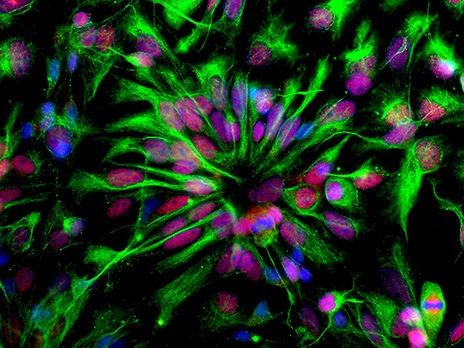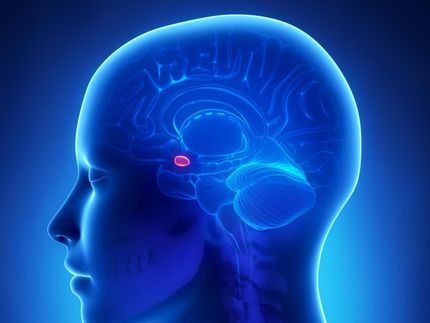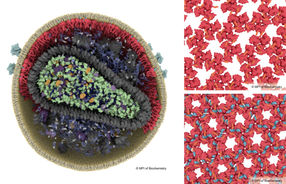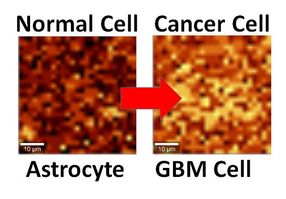Team discovers how Zika virus causes fetal brain damage
Infection by the zika virus diverts a key protein necessary for neural cell division in the developing human fetus, thereby causing the birth defect microcephaly, a team of Yale scientists reported Aug. 24 in the journal Cell Reports.

Human neuroepithelial stem cells self-organize into rose-like patterns and express the typical neural stem cell markers nestin (green) and SOX2 (red). They were used to understand how Zika virus infection works and to block its proliferation.
Yale University / Sestan Lab
The findings suggest that Zika virus might be susceptible to existing antiviral drugs that may prevent disruption to the developing nervous system, said the researchers.
One of the frightening side-effects of Zika virus infection in pregnant women is the risk of fetal microcephaly, in which babies are born with abnormally small brains. The multidisciplinary collaboration of Yale scientists revealed that Zika virus kills stem cells in the brain and disrupts the process of creating brain cells. An analysis shows that the virus diverts a form of the protein TBK1 from its primary job of organizing cell division to the mitochondria, the cell’s power pack, where it helps initiate an immune response. Lacking the protein at the site of cell division, cells die instead of forming new brain cells, resulting in microcephaly. The data suggest this mechanism may also contribute to microcephaly associated with other common congenital viral infections.
Researchers note that an existing FDA-approved drug, Sofosbuvir, showed promise in preventing Zika virus infection of neural stem cells in laboratory culture and also seems to keep phospho-TBK1 involved in cell division. More study needs to be conducted to prove the efficacy of the drug as a medical therapy for Zika virus, the authors said.
“There is an urgent need to identify therapeutic approaches to halt Zika infection, especially in pregnant women,” said Marco Onorati, co-first author of the paper and researcher in the lab of senior author Nenad Sestan, professor of neuroscience, comparative medicine, genetics, and psychiatry. “In the interim, we hope these findings can lead to therapies that might minimize the damage caused by this virus.”
Original publication
Onorati, Marco et al.; "Zika Virus Disrupts Phospho-TBK1 Localization and Mitosis in Human Neuroepithelial Stem Cells and Radial Glia"; Cell Reports; 2016
Most read news
Original publication
Onorati, Marco et al.; "Zika Virus Disrupts Phospho-TBK1 Localization and Mitosis in Human Neuroepithelial Stem Cells and Radial Glia"; Cell Reports; 2016
Topics
Organizations

Get the analytics and lab tech industry in your inbox
By submitting this form you agree that LUMITOS AG will send you the newsletter(s) selected above by email. Your data will not be passed on to third parties. Your data will be stored and processed in accordance with our data protection regulations. LUMITOS may contact you by email for the purpose of advertising or market and opinion surveys. You can revoke your consent at any time without giving reasons to LUMITOS AG, Ernst-Augustin-Str. 2, 12489 Berlin, Germany or by e-mail at revoke@lumitos.com with effect for the future. In addition, each email contains a link to unsubscribe from the corresponding newsletter.


























































